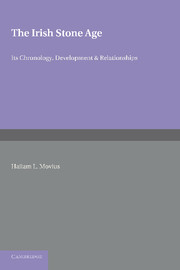Book contents
- Frontmatter
- Dedication
- Contents
- ILLUSTRATIONS
- FOREWORD
- PREFACE
- INTRODUCTION
- Part One THE CHRONOLOGY OF THE LATE-GLACIAL AND EARLY POST-GLACIAL PERIODS IN NORTHERN AND WESTERN EUROPE
- Part Two THE STONE AGE CULTURES OF IRELAND
- Appendices I-VI
- APPENDIX I The Raised Beach of the Third Interglacial Period
- APPENDIX II Deposits of the Interstadial Period between the Old and the New Drift Glaciations (W1/W2) in England and Scotland
- APPENDIX III The New Drift Glaciation
- APPENDIX IV The Recession of the Last Ice-Sheets
- APPENDIX V Deposits of the Late-Glacial Sea
- APPENDIX VI Submerged Forests and Raised Beaches in Britain and Ireland
- REFERENCES CITED IN THE TEXT
- CLASSIFIED LIST OF REFERENCES TO CAVE RESEARCH AND STONE AGE ARCHAEOLOGY IN IRELAND
- ADDENDUM
- INDEX
APPENDIX IV - The Recession of the Last Ice-Sheets
from Appendices I-VI
Published online by Cambridge University Press: 05 June 2016
- Frontmatter
- Dedication
- Contents
- ILLUSTRATIONS
- FOREWORD
- PREFACE
- INTRODUCTION
- Part One THE CHRONOLOGY OF THE LATE-GLACIAL AND EARLY POST-GLACIAL PERIODS IN NORTHERN AND WESTERN EUROPE
- Part Two THE STONE AGE CULTURES OF IRELAND
- Appendices I-VI
- APPENDIX I The Raised Beach of the Third Interglacial Period
- APPENDIX II Deposits of the Interstadial Period between the Old and the New Drift Glaciations (W1/W2) in England and Scotland
- APPENDIX III The New Drift Glaciation
- APPENDIX IV The Recession of the Last Ice-Sheets
- APPENDIX V Deposits of the Late-Glacial Sea
- APPENDIX VI Submerged Forests and Raised Beaches in Britain and Ireland
- REFERENCES CITED IN THE TEXT
- CLASSIFIED LIST OF REFERENCES TO CAVE RESEARCH AND STONE AGE ARCHAEOLOGY IN IRELAND
- ADDENDUM
- INDEX
Summary
At the time of the maximum advance of the last ice-sheets, minor oscillations occurred along the margin of the ice-front, as shown by the York and Escrick moraines and the overriding of sands andgravels by boulder clay near Hull, mentioned on p. 270. According to Charlesworth (1928, pp. 295-300) this also happened in Ireland. The melt-water escaped via the principal river valleys, into which flowed streams heavily loaded with sediments. The material was ultimately discharged in the form of outwash fans and trains, spread over the valleys, and subsequently carved into terraces and redeposited by Late-Glacial and Early Post-Glacial rivers. Marginal drainage channels and other recessional phenomena existed everywhere along the edge of the waning ice. In many cases the melt-water was impounded and extra-glacial lakes formed, but it would be impossible to describe these within the limits of the present book. The reader, especially if he be interested in investigating the possibility of establishing a geochronological timescale for the recession, is referred to the bibliography where innumerable exposures of Late-Glacial laminated or varved clays are recorded. Similarly the writer does not intend to discuss minor stages in the recession established in many areas; these were formed during the early stages of the recession when the ice began to melt. As the melting advanced the retreat was accelerated, but it was not a steadily progressive withdrawal. Instead it was interrupted by prolonged harks and periods of readvance which are of great importance for purposes of chronology. Only the major stages, therefore, which broke up the recession into several clearly defined periods, are of immediate concern. In Ireland, when actual retreat began, the Irish Sea Ice withdrew northwards in such a way that its western edge curved over the coastal plain and out to sea (Charlesworth, 1937, PP- 32~4)- West of the Wicklow Hills, which acted as a pivot for the melting Ivernian Ice, the sinuous margin fell away in a series of tangential curves, and the moraines, which are festooned between Wicklow and the west coast, show clearly the early history of the ice-retreat in this area (Charlesworth, 1928, p. 326).
- Type
- Chapter
- Information
- The Irish Stone AgeIts Chronology, Development and Relationships, pp. 273 - 283Publisher: Cambridge University PressPrint publication year: 2013



